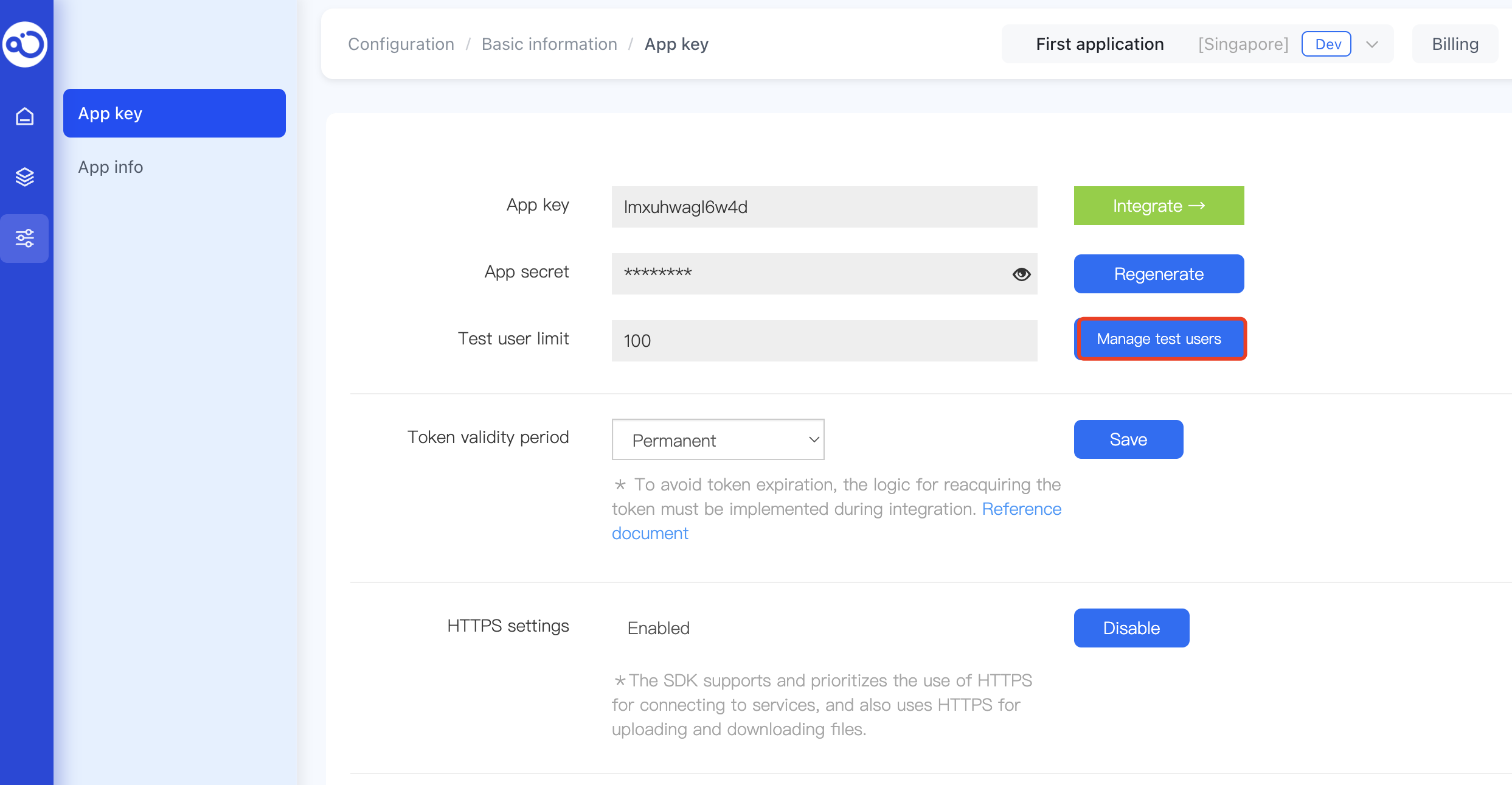User Overview
App users need to connect to the IM Service to use it. For the IM Service, a user refers to an App user who holds a valid Token issued by the IM server and connects to and uses the IM Service.
Registering Users
The App Server should provide the user ID (userId) of the App user to the IM server to obtain a unique user Token. For the IM Service, this step of obtaining a Token with userId is referred to as [registering a user], and it must be completed by calling the Server API.
The App client must hold a valid Token to successfully connect to the IM server and use the IM Service. When an App client user sends a login request to the server, the server checks if the connection request matches.
Limits on Registered Users
- The maximum number of registered users in the development environment? is 100.
- In the production environment?, there is no limit on the number of registered users after upgrading to the Chat Premium Plan or Chat Ultimate Plan. You can switch the current billing plan version in the Console.
Deleting Users
Deleting users refers to removing registered test users in the development environment through the Console to control the total number of test users in the development environment. This operation is not supported in the production environment.

Deactivating Users
Deactivating a user refers to deleting user data in the IM Service. Apps can use this capability to implement their own user deactivation functionality to meet App store or compliance requirements.
After the IM Service returns a successful deactivation result, data related to the user ID is deleted. You can query all deactivated user IDs from the IM server. If needed, you can reactivate a deactivated user ID (note that user personal data cannot be restored).
Only the IM Server API provides this capability.
User Information
User information generally refers to data such as the user's nickname, avatar, group nickname, and group avatar. RC does not store or maintain your App's user information data by default, and you need to maintain user data on the App side. If you need to store your App's user profile information in RC, you can enable and use RC's User Profile Hosting service to store and maintain user profile information in RC.
Friend Relationships
By default, RC's IM Service does not synchronize or save friend relationship data from the App side, and it needs to be maintained by the App Server. If you need to use RC's friend relationship management service, you can enable RC's User Profile Hosting service. Once enabled, you can manage user friend relationships through the friend relationship management service provided by RC.
If you are not using RC's friend relationship management service and need to restrict message sending and receiving behavior between client users (for example, if all userIds of the App are leaked, allowing a malicious user to bypass friend relationships and send messages to any user), you can consider using the User Allowlist service. Once a user enables and sets an allowlist, they can only receive messages from users in that allowlist.
If you use RC's friend relationship management service, non-friends can send messages to each other by default. If you need to restrict it so that only friends can send messages, you can enable the "Only friends can send one-to-one chat messages" feature in Developer - User Profile Hosting Service - Feature Settings.
User Management APIs
| Function Category | Description | Server API |
|---|---|---|
| Register User | Use the App user's user ID to obtain a Token from the IM server. | Register User |
| Delete User | Refer to the Deleting Users section above. | Not provided |
| Expire Token | Expire Tokens obtained before a specific time. | Expire Token |
| Deactivate User | Deactivate a user refers to disabling the user ID in the IM Service and deleting user personal data. | Deactivate User |
| Query Deactivated Users | Get a list of deactivated user IDs. | Query Deactivated Users |
| Reactivate User ID | Reactivate a deactivated user ID in the IM Service. | Reactivate User ID |
| Set User Information on the IM Server | Set the user name and avatar used in the IM Service's push notification service. | No separate API is provided. User information must be provided during Register User. |
| Get User Information from the IM Server | Get the user's registered information in the IM Service, including the user creation time and the user name and avatar URL used by the server's push notification service. | Get Information |
| Modify User Information on the IM Server | Modify the user name and avatar used in the IM Service's push notification service. | Modify Information |
| Ban User | Prevent a user from connecting to the IM Service and immediately disconnect them. Can be unblocked after a set duration or manually. Query the user ID and ban end time of banned users. | Add Banned User, Unblock User, Query Banned Users |
| Query User Online Status | Query the online status of a user. | Query Online Status |
| Add to Blocklist | Add a user to a user's blocklist. Users in User A's blocklist cannot send messages to User A. | Add to Blocklist |
| Remove from Blocklist | Remove a user from a user's blocklist. | Remove from Blocklist |
| Get Blocklist | Get a user's blocklist. | Query Blocklist |
| User Allowlist | Once a user enables and sets an allowlist, they can only receive messages from users in that allowlist. | Enable User Allowlist, Query User Allowlist Status, Add to Allowlist, Remove from Allowlist, Query Allowlist |
Only the blocklist feature provides a client API. All other APIs in the table above are server APIs only.